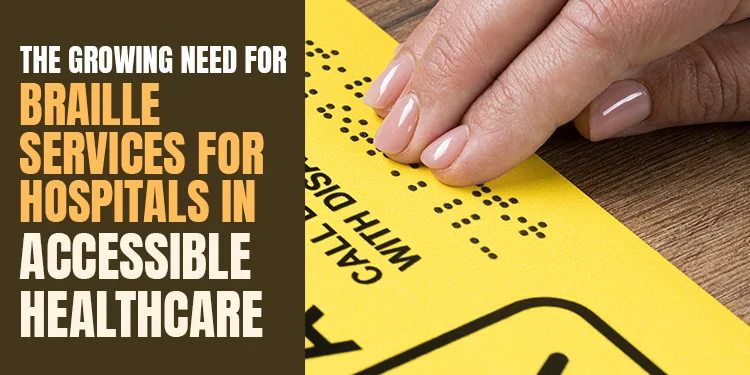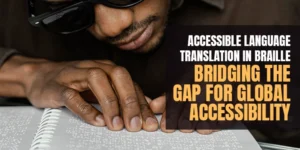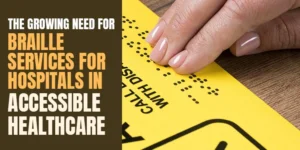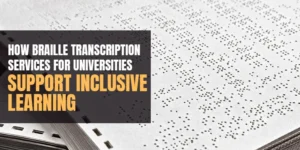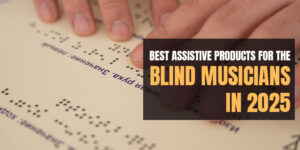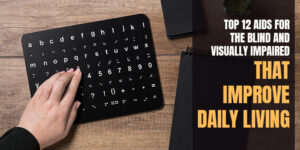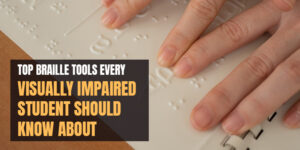Accessibility for healthcare goes beyond offering elevators or ramps. True accessibility is clear communication with patients suffering from visual impairments. For hospitals, clear communications could help save lives, increase trust among patients, and increase the quality of healthcare. This is the reason why the need for Braille Services for hospitals is rapidly growing across the United States.
Why Accessible Communication Matters in Hospitals
In hospitals, patients have to understand the instructions clearly. For those who have difficulty seeing printed signs and permission forms, prescribed medications and discharge notes may present challenges. Without these resources in braille, patients might feel isolated or unable to control their treatment effectively.
The accessibility of communication is essential to ensure equality in the field of healthcare. Patients can be kept updated on their condition as well as treatment, and recovery. When hospitals employ braille, they show respect, compassion, and inclusion.
The Role of Braille Services in Modern Healthcare
Braille Services for Hospitals include transcription of vital medical documents, design of Braille signage, as well as the translation of instructions for discharge. These services enable visually impaired and blind patients to get the same information as patients who are sighted.
Examples of Braille use in hospitals include:
- Room signs that have Braille numbers for navigation.
- Labels for prescriptions in braille to prevent mistakes with medication.
- Consent and Procedure form in braille, to help you make informed choices.
- Health educational resources are translated into braille for continuing patient learning.
Through the integration of braille into the hospital system, medical professionals make sure that no patient is uninformed because of a lack of accessibility.
Legal and Ethical Responsibility of Hospitals
The Americans with Disabilities Act (ADA) stipulates equal access for those with disabilities. Although a majority of hospitals meet physical accessibility standards, communication issues often remain. The provision of Braille materials helps bridge the gap and is in line with ADA compliance.
Beyond the legal obligations, in addition to legal requirements, hospitals are bound by an ethical responsibility. Patients shouldn’t be forced to depend on their caregivers or family members to interpret sensitive medical information that is sensitive. The independence of healthcare creates confidence, dignity, and dignity.
Patient Safety and Braille Integration
The safety of patients is dependent on open and clear communication; for patients with visual impairment, misinterpreting dosages of medication or treatment guidelines can result in serious injury. Labels for prescriptions and discharge instructions help reduce the risk.
Hospitals that invest in braille Services for hospitals safeguard patients from medical mistakes. This proactive approach helps create an environment that is safer for all patients.
Building Trust and Comfort Through Braille
When hospitals offer Braille assistance and services, they convey a powerful message: each patient is valued. Visually impaired patients frequently feel ignored in the traditional healthcare setting. Braille-based materials give them an environment of acceptance and respect.
Trust plays an important role in the satisfaction of patients. Patients who feel valued and valued have a higher likelihood to stick to treatment plans, return to the hospital for treatment follow-up, and refer others to the hospital.
How Hospitals Can Implement Braille Services
Hospitals can make use of Braille services in various practical ways:
- Partner with professionals in Braille transcription services.
- Create Braille signs throughout areas, including bathroom rooms, elevators, and exits.
- Offer Braille versions of forms for consent, directions, and other policies.
- Provide Braille-labeled packaging for medications at pharmacies.
- Help staff to be aware of disabilities as well as how they can disseminate Braille materials efficiently.
These steps don’t require major restructuring, but they affect healthcare.
The Future of Accessible Healthcare
The healthcare industry is moving towards patient-centered care. The accessibility of healthcare isn’t an option but a requirement. As hospitals move towards the digital age, they also have to provide accessibility to people who rely upon tactile reading.
Future hospitals will include braille along with the large-print, sound, as well as digital accessibility devices. This multi-access method ensures that all patients have access to information regardless of their disability.
Conclusion
The increasing demand for Braille services for hospitals emphasizes the necessity of ensuring inclusive healthcare. Hospitals that are embracing braille do not just meet ADA standards, but also show kindness and respect to visually disabled patients. When they invest in Braille transcribing, signs, and patient documentation, hospitals create safer, more secure, and accessible healthcare environments.
Each patient deserves easy, clear, and independent communication. Braille helps bridge gaps between health care institutions and patients who require the most.
In Braille Music and More, we provide expert transcription in braille specifically to hospitals and health facilities. From educational materials for patients, including prescription labels to signs, we assist hospitals in complying with accessibility standards while also increasing the trust of patients.
Reach out to Braille Music and more today to find out how we can help your hospital’s mission of providing patients with holistic and personalized care by providing efficient Braille services.

